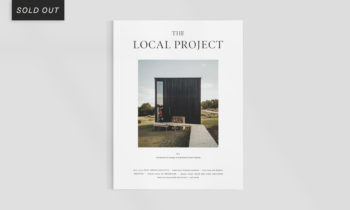To Coexist Without Integrating: The Bluff House by Rob Kennon Architects
Project Feature
Flinders, VIC, Australia

Emerging from amongst coastal sheoaks and banksias, the reflective glass façade of the Bluff House by Rob Kennon Architects mirrors the surrounding vegetation yet instantly marks the structure as foreign to the natural environment. Embracing this tension, the project sits as an object within its wider context, coexisting without integrating, compelling without dominating – a home within, but not of, the landscape.
Cutting through the site is a meeting point of two geologies, creating a fault line unable to be built upon. In response, the architects designed a basement submerged two-thirds beneath the ground, abutting the fault-line, that acts as a large occupied footing, anchoring the house deep into the escarpment. Above ground, two parallel plates cantilever off reinforced blockwork to extend the building footprint over the land slip-affected terrain created by the fault line.
The result is a building whose form appears to float above the ground, barely resting upon its surface. This appearance conceals the reality of a home that is literally embedded within the site, the design juxtaposing an enclosed, subterranean volume with a cantilevered main building pavilion. The basement, whose upper third above ground admits light and ventilation, houses the children’s bedrooms and a playroom, while two master bedrooms and living space are situated above ground.
The project sits as an object within its wider context, coexisting without integrating.
“It was important to have these very contrasting types of spaces,” explains Rob Kennon. “You have got the vastness of the main living and bedroom spaces, and then this quiet retreat below ground that is climatically neutral, and acoustically and aesthetically quiet, that lends itself to a different programme.” In this way, the design engages with very different kinds of space and forms of shelter that frame the experience of both the landscape and the home for its inhabitants.
While the main pavilion offers panoramic views to the ocean and vegetation beyond, it nevertheless deliberately mediates the experience. The impact of the horizontal floor and ceiling planes creates a consistent datum that correlates to the vast horizon, at once amplifying yet precisely delineating the context. “There is no doubt when looking outward that you are viewing from an abstract platform; it’s undoubtedly foreign,” Rob reflects.
“It was important to have these very contrasting types of spaces.”
This is consistent with the architects’ and clients’ shared belief that the building should not seek to dominate the landscape. “We wanted to create a sense of separation to a degree, primarily because neither we nor the client wanted it to be an overpowering building in the landscape,” says Rob. Thus, the home’s studied sense of separation is a means of amplifying the context, finding balance through the tension between detachment and connection.
Such an approach is a deliberate move away from the Australian coastal typology that seeks elevation and prospect at all costs, and which leads to nondescript architectural outcomes irrespective of context or place. In contrast to this highly general dominant typology, the Bluff House is deeply influenced by its milieu. And while the project’s deliberate separation may initially seem contrary to a greater sense of connection, the design’s modest footprint and low-lying pavilion, with the shadow line created by the partially exposed lower level, results in a sense of being suspended within but not detached from the landscape.
“There is no doubt when looking outward that you are viewing from an abstract platform; it’s undoubtedly foreign.”
One’s sense of both place and built form is further informed by the external spaces in the Bluff House, which act as both outdoor rooms and intermediary zones between indoors and out. The roof overhead and texture of the sedimentary stone laid underfoot lends these outdoor balconies a spatial quality and reinforces the impression of living on a platform within the landscape. Rob describes the balconies as “negatives as opposed to positives – rather than adding, we’ve subtracted something, carving these spaces out from the form.”
These ‘subtracted’ spaces, in conjunction with moveable dark-stained spotted gum batten screens, cause the building to visually recede. Reflective glass to the southern elevation serves a similar purpose, though by dramatically contrasting means. The timber-clad sides and elevations where balconies have been carved out create an aporia within the structure that causes the eye to glide softly through and across. In contrast, the expanses of glazing reflect the landscape and sky back outwards. Even as the glass is mirroring the landscape, the industrial nature of the material marks it as other.
“Negatives as opposed to positives – rather than adding, we’ve subtracted something, carving these spaces out from the form.”
Stepping inside, the material palette is inverted. Here the expanses of glazing send the eye outwards, while timber-clad walls enclose and protect. Meanwhile, the external moveable batten screens create permeable walls that give the inhabitants greater control over the internal environment. Open, the full impact of the view is felt. Closed, they shelter the space against the harsh western sun and create a dappled light that changes throughout the day. As with the external form, the interior is marked by its clarity and simplicity, yet enlivened by the graphic stripes of light and shade, and the depth and texture of both sedimentary stone flooring and timber.
By embracing the tension inherent in creating a detached form within the landscape in order to create a more genuine connection, The Bluff House achieves a remarkably distilled clarity of design. This tension is a continuous thread throughout the project, informing the juxtaposition of materials, the balance between exposure and protection, and the incongruence of a suspended platform that is in fact submerged within the site. The result is a building content to coexist with the landscape, not dominating in its presence, yet compelling in its otherness.












































































